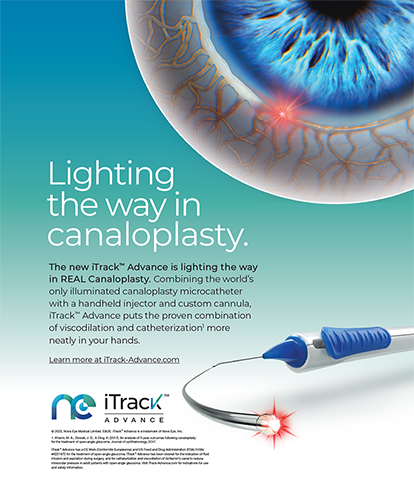

There is no better time to be a cataract surgeon or patient. New technology bolsters efficient and safe surgery and superb visual outcomes. Nearly 25 million eyes worldwide have cataract surgery each year.1,2 Despite the use of modern technology, posterior capsular opacification (PCO) is a complication that occurs in some cases.
There are no definitive data on PCO formation, but studies show that it occurs in 20% to 50% of eyes.3,4 Preventing lens epithelial cells from proliferating and obscuring vision is an elusive goal. Until PCO formation can be fully prevented, Nd:YAG laser treatments will continue to play an essential role in its treatment. Several fundamental concepts may help to optimize outcomes.
1. WHAT IS AN ND:YAG LASER?
Yttrium aluminum garnet (YAG) is a synthetic crystalline material. Neodymium (Nd), a rare earth element, is added to YAG to induce atomic excitation and produce lasing capabilities of the crystal.5
The Nd:YAG laser has a wavelength of 1,064 nm, which is in the infrared range. Its effect on tissue is caused by photodisruption that occurs as highly focused light energy produces plasma. The plasma expands and then collapses to generate an acoustic shock wave. The Nd:YAG’s second laser light (HeNe) is an aiming beam used to help the surgeon visualize where the photodisruption will take place. The infrared laser beam converges posterior relative to the red aiming beam due to chromatic aberration. Newer lasers may compensate for this effect.6,7
2. THE PATIENT DISCUSSION
Although it is generally a safe procedure, the main risks and potential implications of an Nd:YAG capsulotomy must be discussed with the patient during the consent process.
Risks. Retinal detachment is a potential complication after capsulotomy. The incidence of retinal detachment after Nd:YAG capsulotomy is approximately 1% or less.8-10 Other complications include short-term IOP elevation, lens damage, iridocyclitis, cystoid macular edema, decentration or dislocation of the IOL, and, rarely, endophthalmitis.11
Refractive outcomes. Clinical experience and research validate that Nd:YAG capsulotomy improves refractive outcomes and decreases visual disturbances. A lens shift after capsulotomy, however, may negatively affect the patient’s refraction. Techniques that may reduce this risk are outlined under fundamental No. 4.
Presbyopia-correcting IOL considerations. The majority of patients who receive presbyopia-correcting IOLs require a posterior capsulotomy. The timing of the procedure is particularly important with these lenses. When patients present with glare, halos, or other visual phenomena, it can be easy to fault PCO. Other potential sources of visual disturbances, however, should be ruled out or addressed before an Nd:YAG capsulotomy is performed. If an IOL exchange is necessary after a posterior capsulotomy, surgery may be more challenging.
3. LASER PREPARATION AND TECHNIQUE
Laser settings depend on the surgeon’s preferences and the case. Understanding the role of power, laser offset, and a focusing lens can help to optimize results.
Laser power. A power setting of 1 to 2 mJ is sufficient for routine capsulotomies, but dense opacities may require additional power. The benefits of lower power include transmitting less energy to the hyaloid face, which decreases the risk of IOL dislocation and retinal traction. Also, a lower power produces a smaller shock wave that is less likely to damage the lens.12
Laser offset. The laser offset moves the point of laser convergence farther posterior to the HeNe light beam. This is helpful because the optical focus breaks down in the vitreous, and the shock wave is transmitted anteriorly. This setting decreases the odds of lens damage, particularly where there is no space between the capsule and IOL.12
Focusing lens. A capsulotomy lens steepens the angle of the laser beam, decreases the beam diameter at the posterior capsule, and widens the beam diameter at both the retina and cornea.12 The focusing lens increases accuracy and efficiency and decreases the risk of lens damage. Many surgeons, however, routinely perform an Nd:YAG capsulotomy without a focusing lens with excellent results.
4. SURGICAL TECHNIQUE and Postoperative Care
There is no consensus on the optimal technique for an Nd:YAG capsulotomy, but several studies point to the impact different methods have on patient outcomes.
Capsulotomy size. Original reports recommended clearing only the visual axis of opacity. More recent studies indicate that a smaller capsulotomy may lead to glare or fail to eliminate presenting patient complaints13 and an overly large capsulotomy increases the risk of IOL dislocation. Even if the IOL doesn’t dislocate, a posterior shift of the optic can cause a hyperopic refractive shift.14 Additionally, a YAG opening that extends beyond the edge of the optic could lead to vitreous prolapse. One approach is to create a capsulotomy that approximates the scotopic pupil size while maintaining overlap with the posterior aspect of the optic to maximize the removal of opacity and preserve IOL position.
Cruciate versus circular shot applications. Most surgeons prefer either a cruciate or a circular application of shots. Research has shown interesting differences between the techniques. A cruciate approach might lead to a lower incidence of postprocedural complaints of floaters.15 Although both techniques decrease the total ocular scatter index, the decrease may be more pronounced with application of a circular pattern.16
Lens damage. Pitting of the lens may occur during Nd:YAG capsulotomy. Fortunately, light scattering measurements taken after capsulotomy showed no significant differences in damaged lenses compared to normal eyes.17 Understanding the laser’s focusing capabilities, using a capsulotomy lens, reducing power settings, and utilizing the laser offset settings may help to reduce the incidence of lens damage.
Postoperative care. Treatment in the postoperative period varies. IOP spikes can occur in 15% to 67% of cases, and some surgeons will wait to check IOP until about 15 to 30 minutes after surgery. The instillation of an aqueous suppressant is suggested as prophylaxis. Pressure typically normalizes within 1 week postoperatively.12
A steroid may be used for the first several days to reduce the risk of inflammation and cystoid macular edema. Patients should be seen 1 to 2 weeks after the procedure for a dilated eye examination and to check the refraction of the eye.
5. OTHER USES OF THE YAG
Anterior capsular contraction syndrome. Also known as phimosis, anterior capsular contraction syndrome occurs when the anterior capsule contracts and opacifies. This may affect visual acuity, cause glare and halos, and result in a shift of the IOL. Relaxing incisions can be made in the anterior capsule with an Nd:YAG laser. These incisions are often placed in a quadrantic pattern or as multiple radial incisions around the optic.
Capsular block syndrome. This complication occurs when an OVD or fluid becomes trapped between the optic and posterior capsule, and it typically results in a myopic shift. Posterior capsulotomy facilitates the diffusion of fluid into the vitreous, whereas shots placed in the peripheral anterior capsule allow diffusion into the anterior chamber. In rare cases, the material may be infectious or inflammatory, which can necessitate additional intervention.18
Z-syndrome. Z-syndrome occurs when an accommodating IOL develops an asymmetric vault due to the posterior bending of one haptic and the anterior bending of the other. It can often be corrected by placing radial shots over the kinked haptics.19
CONCLUSION
A comprehensive understanding of the Nd:YAG laser’s functions and the anatomic changes that occur after the laser capsulotomy allows physicians to better prepare their patients for the procedure. Despite the routine nature of the laser capsulotomy, ophthalmologists must remain meticulous and vigilant when performing the procedure in order to provide safe care and excellent outcomes to their patients.
1. Surgical operations and procedures statistics. Eurostat Statistics Explained. Updated October 13, 2020. Accessed January 29, 2021. http://ec.europa.eu/eurostat/statistics-explained/index.php/Surgical_operations_and_procedures_statistics
2. Lindstrom R. Thoughts on cataract surgery. Review of Ophthalmology. March 9, 2015. Accessed February 18, 2021. https://www.reviewofophthalmology.com/article/thoughts-on–cataract-surgery-2015
3. Apple DJ, Solomon KD, Tetz MR, et al. Posterior capsule opacification. Surv Ophthalmol. 1992;37(2):73-116.
4. Apple DJ, Peng Q, Visessook N, et al. Eradication of posterior capsule opacification. Ophthalmology. 2001;108:505-518.
5. Ready JF. Advanced glass-ceramic nanocomposites for structural, photonic, and optoelectronic applications. In: Karmakar B, Rademann K, Stepanov A, eds. Glass Nanocomposites, 1st ed. William Andrew/Elsevier; 2016:299-338.
6. Fankhauser F, Kwasniewska S. Lasers in Ophthalmology: Basic, Diagnostic, and Surgical Aspects: a review. Kugler Publications; 2006.
7. Yanoff M, Duker JS, Augsburger JJ. Ophthalmology. 3rd ed. Mosby/Elsevier; 2009:497-502.
8. Grzybowski A, Kanclerz P. Does Nd:YAG capsulotomy increase the risk of retinal detachment? Asia Pac J Ophthalmol (Phila). 2018;7(5):339-344.
9. Wesolosky J, Tennant M, Rudnisky CJ. Rate of retinal tear and detachment after neodymium:YAG capsulotomy. J Cataract Refract Surg. 2017;43:923-928.
10. Karahan E, Er D, Kaynak S. An overview of Nd:YAG laser capsulotomy. Med Hypothesis Discov Innov Ophthalmol. 2014;3(2):45-50.
11. Chaudhry M, Baisakhiya S, Bhatia MS. A rare complication of Nd-YAG capsulotomy: propionibacterium acnes endopthalmitis. Nepal J Ophthalmol. 2011;3(1):80-82.
12. Steinert RF. Nd:YAG laser posterior capsulotomy. AAO. November 4, 2013. Accessed January 30, 2021. https://www.aao.org/munnerlyn-laser-surgery-center/ndyag-laser-posterior-capsulotomy-3
13. Mackool R, Mackool R, Monsanto V, Stoj V. Size matters: Are complications of Nd:YAG laser posterior capsulotomy related to their dimensions? Is bigger better? Cataract & Refractive Surgery Today. July 2018. Accessed February 18, 2021. https://crstoday.com/articles/july-2018/size-matters/
14. Karahan E, Tuncer I, Zengin MO. The effect of ND:YAG laser posterior capsulotomy size on refraction, intraocular pressure, and macular thickness. J Ophthalmol. 2014(4):846385.
15. Cetinkaya S, Cetinkaya YF, Yener HI, Dadaci Z, Ozcimen M, Acir NO. The influence of size and shape of Nd:YAG capsulotomy on visual acuity and refraction. Arq Bras Oftalmol. 2015;78(4):220-223.
16. Kruijt B, van den Berg JTP. Optical scattering measurements of laser induced damage in the intraocular lens. PLoS One. 2012;7(2):e31764.
17. Li J, Yu Z, Song H. The effect of capsulotomy shape on intraocular light-scattering after Nd:YAG laser capsulotomy. J Ophthalmol. 2020;2020:4153109.
18. Patel A, Mammo DA, DelMonte DW, Masters JS, Tripathy K. Capsular bag distension syndrome. Eyewiki. Updated June 21, 2020. Accessed February 3, 2021. https://eyewiki.org/Capsular_bag_distension_syndrome
19. Safran SG. Treatments for Z syndrome. Cataract & Refractive Surgery Today. January 2016. Accessed February 18, 2021. https://crstodayeurope.com/articles/2016-jan/treatments-for-z-syndrome/




